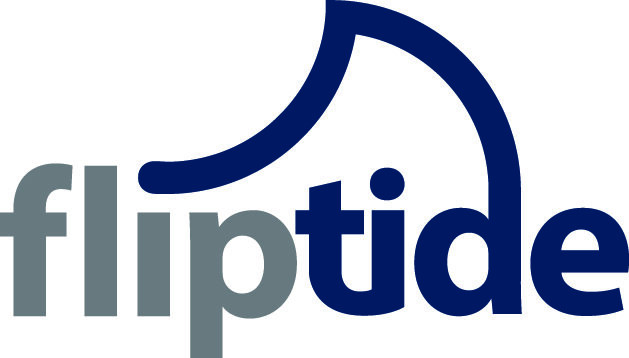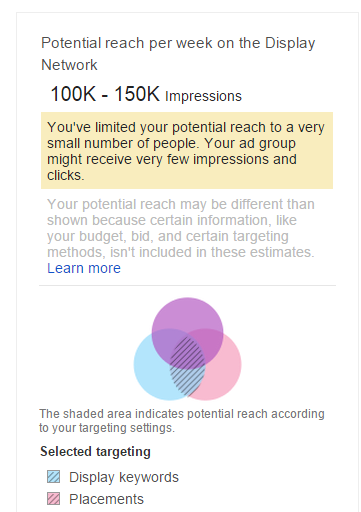 Continuing with my tips on Google Adwords, today I explain what you need to know once you have completed the initial campaign set up process as described in part one. The following pertains to display advertising which shows ads on the millions of websites Google has partnered with through its network.
Continuing with my tips on Google Adwords, today I explain what you need to know once you have completed the initial campaign set up process as described in part one. The following pertains to display advertising which shows ads on the millions of websites Google has partnered with through its network.
Targeting
One thing you should be aware of is that there are different targeting options which determine who your ads will,be shown to. You can target websites based on keywords, topics, interests, and demographics. Google then determines which sites to show your ads on based on what you specified. You can also choose individual websites (called placements on Google) where you specify exactly what websites you want your ad to appear on.
The Google display planner can help you determine which sites to target based on a relevant term you enter. For example, if your organization focused on disaster relief, you would enter that term and the display planner would provide a list of keywords, topics, interests and demographics you might consider targeting. Look these over carefully since only you know what’s relevant.
The real power behind targeting is the ability to mix and match the various options so your ad gets shown to those who are most interested in seeing it. For example, if you were creating ads for an organization raising money for cancer, you might choose keywords related to the type of cancer you are treating and combine it with a topic category of charity and philanthropy. This will show your ads on sites that contain those keywords and only within sections that focus on charity and philanthropy. That way you won’t be wasting advertising dollars on scientific journals for example which cater more to researchers and scientists than donors. Similarly, you might choose to show your ads on the New York Times and by choosing health as a topic the ad will show in their health section. The following article does an excellent job of further explaining the different combinations of targeting options available.
Bidding Options
One concept that can be a little difficult to grasp is how restrictive to make your audience when combining targeting options.
In the example above, you would have chosen your cancer keywords and then your topic of charity and philanthropy. Because we wanted to limit the sites featuring our ads to those containing our keywords AND the topic of charity and philanthropy we would set the topic to target and bid.
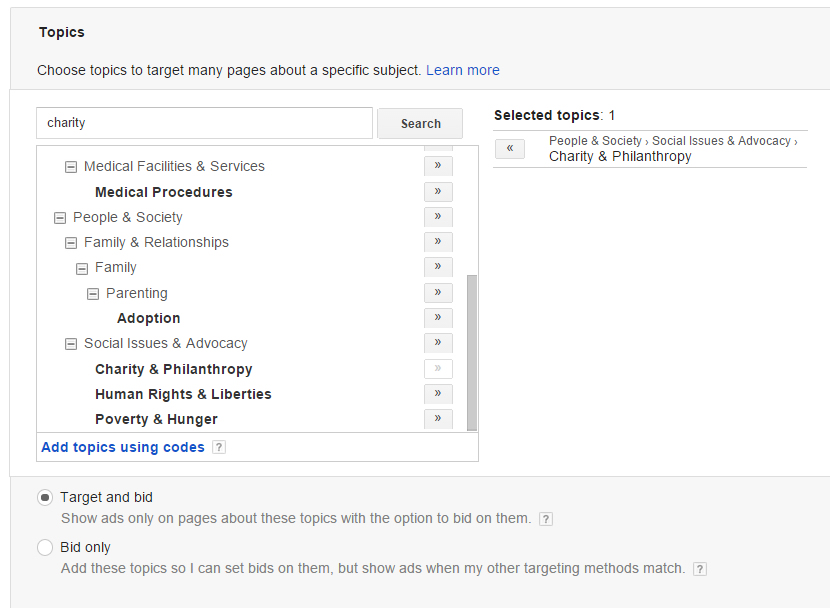
The advantage is a more targeted audience. However, you need to take into account the number of people who will see your ads. Google provides an estimate for you once you have picked your topics. If it’s too small you need to re-evaluate.
One way too reach more people is by choosing bid only instead. This tells Google, to show your ads when EITHER of the criteria you have selected are met – not both. Your ad will show on sites that only have the term “disaster relief” and it will show on sites that only have the topic charity and philanthropy (it would of course show on sites that meet both criteria as well).
In both scenarios, you can bid higher for certain targets that you think might be produce better results.
In the bid only scenario, if you chose the topic charity and philanthropy you could hand pick certain placements like the Washington Post and bid more for those because they are valuable to you. The Washington Post may have shown your ad anyway if it had a topic related to charity and philanthropy but by bidding higher for that placement you increase your chances that it will.
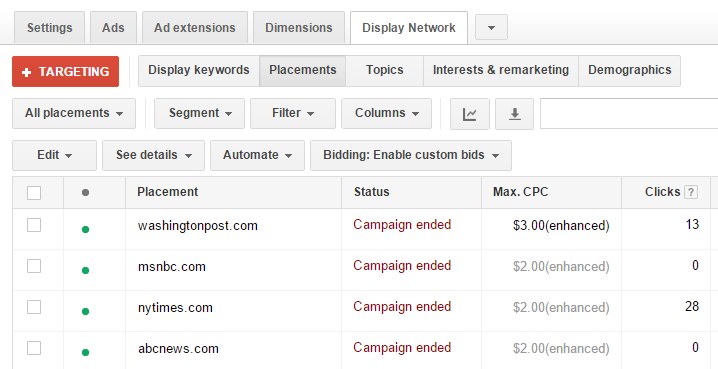
Similarly, with target and bid, you could bid more for certain targeting options like keywords, especially if you see that they are producing good results.
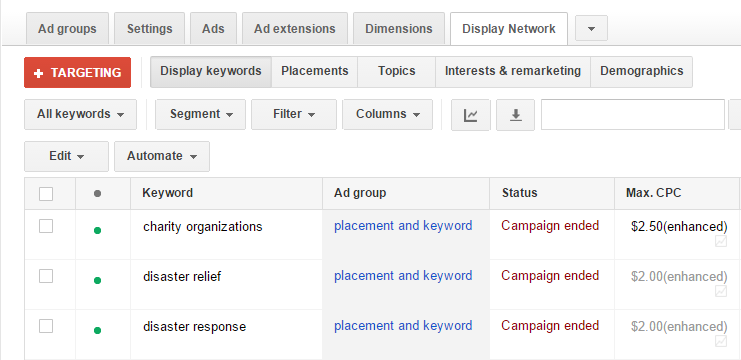
Excluding Mobile Apps
You might be surprised to hear that you should exclude your ads from appearing on mobile apps given all the talk about mobile these days. However, an Adwords representative I spoke with confirmed that the quality of the clicks you will receive from mobile appps are often inferior. People may click on them but they usually do so out of curiosity and rarely follow through on your call to action. To remove mobile sites go to your campaign and on the display network tab click the red button labeled exclusions.
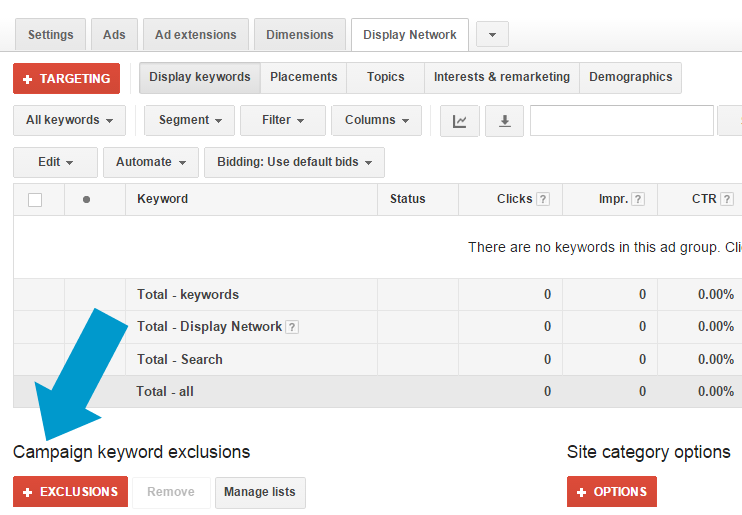
On the following screen choose ‘placements’ from the campaign exclusions tab at the bottom. Paste adsenseformobileapps.com into the dialog box. Next, go back to the previous screen and choose site category options from the menu under campaign exclusions tab.

Then from the list on the accompanying screen choose the exclude option for both In-Game and GMob mobile app non-interstitial.
Choosing Keywords
One thing people don’t realize when choosing keywords for sites they want their display ads to be shown on is that match types apply in the same way they do with search ads. For example, if you are working for an animal welfare organization, entering the keyword “animal welfare” could result in your ad showing on sites with “animal welfare journal” and “animal welfare jobs” in the text. To prevent wasted advertising dollars, you might consider selecting +animal +welfare +organizations. Known as modified broad match targeting, this tells Google to only show your ad on sites that contain these keywords. It also makes sense to add keyword exclusions which prevent your ads for from showing and are basically the same as negative keywords in Google search ads.
Wrapping It Up
While the key to successful advertising on Google is undoubtedly the quality of your ad and the landing page it leads to, every advantage helps. Hopefully these tips will lead to better results and prevent you from wasting your valuable advertising dollars. Good luck.
[feather_share size=”32″]
